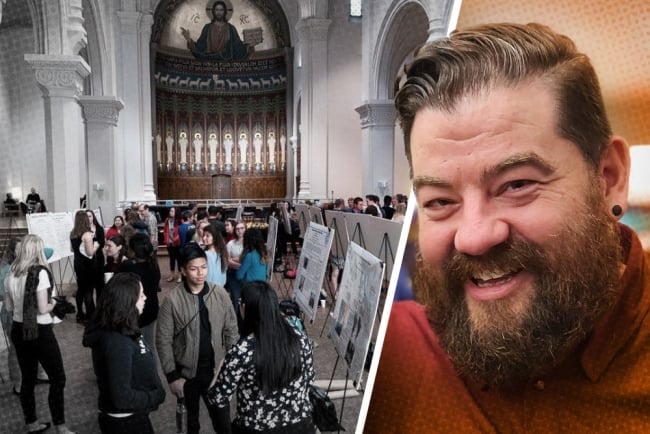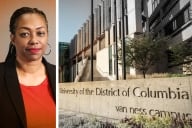You have /5 articles left.
Sign up for a free account or log in.

Andrick will serve as the dean for academic success for Saint John’s University and the College of Saint Benedict, supporting students in their academic and co-curricular success.
SJU/CSB
As a student, John Andrick didn’t realize working at a college or university was a career for people other than athletics coaches and faculty members.
“It just never clicked to me that those people were career professionals making a career out of working in college,” Andrick says.
It was Andrick’s passion for college students and their development that pushed him to consider a career in higher education and has spurred his interest in student success. In September 2023, Andrick became the inaugural dean for academic success at the College of Saint Benedict and Saint John’s University—partner institutions located a few miles apart in Minnesota—serving at the intersection of academic affairs and student support services to benefit students’ retention and completion.
Andrick spoke with Inside Higher Ed about his role, the challenges facing today’s college students and his goals within his first year at the college and university.
Q: What’s so special about working with college students for you?
A: I think they’re at a really fascinating time in their development. I studied secondary education for the bulk of the time I was in my undergraduate and I remember at one point being asked if I wanted to pursue a middle school endorsement, I was like, “Absolutely not. Middle schoolers are the worst, I don’t want anything to do with that.”
[I] came to this realization with college students that these are human beings that are learning how to be an adult, they’re human beings that are really, for the first time, out on their own, figuring out who they are independent from their families, independent from their home communities, independent from the things that they did in K-12 that defined who they are. They’re now getting to set the course for themselves. That is incredibly exciting to me.
But I also know how terrifying that can be as a student, and I think if I can be one of those people that’s there to reassure them that this is exciting, and not scary, and that, in a lot of ways, there’s no wrong decisions to make, it’s just opportunities to learn.
That’s part of what makes them so exciting to me … They are breaking out on their own. It is an exciting time in human development for me and I love being a part of it.
Q: What is your new role and what’s in your purview?
A: It’s a role that really lives at the crux of student development and academic affairs, which is, in a lot of ways, what appealed to me.
Our model is we all—academic affairs and student affairs—report up to the provost under what’s now the title of student success overall.
I technically am on the academic side of that, but I work incredibly closely with our student development partners on things like orientation, first-year experience. My role is intended to focus on the overarching idea of student success that’s really based in the classroom. But yet, it can’t ignore all of those other things. We need our students to feel like their basic needs are being met. If we don’t have those met, they’re not going to be successful in the classroom.
It’s primarily focused on those academic pieces, things like tutoring, advising, accessibility services, academic support services and those types of roles. But it cannot happen in a vacuum, and it has to be done in conjunction with our faculty and our curriculum. And it also has to be done in conjunction with our student development and those areas on campus as well.
Q: That seems like it would be a challenging niche to live in. How do you handle that dynamic? Where do you see the opportunities in that niche, as well?
A: At times, it’s been confusing for me and others, again, in part, because—where do you live? Probably the underlying foundations and philosophy of the work that I do would be grounded in student development theory. But yet, I’m focusing on these academic pieces.
We all know, too, that that these are not worlds that always play well together, there’s often a divide philosophically between the academic arm and the student affairs arm as far as what they want to approach, how they want to approach things, what their focus is going to be. But what’s exciting to me is that opportunity to build bridges between those divides.
It’s a good opportunity for me to serve as a translator between the two areas as well, helping our student development partners understand really what academics is trying to accomplish, while also helping your academic partners understand what our student development folks are trying to accomplish. And really, where they’re actually pulling in the same directions, they might just use different terminology for it, or they may have their priorities in slightly different orders. But ultimately, the priorities are the same.
We all want these students to start here and to finish here, to earn their credentials, and then to move on to be successful in their careers. And if we can all recognize that that’s the direction that we’re pulling in, then ultimately, I think the partnership is easier to understand.
I think COVID also helped us realize that students are whole people. We had assumptions about our students for years in terms of how their personal lives, their financial lives, their social lives, were impacting their academics. COVID really shined a spotlight on those kinds of things. We knew we had students who were food insecure, but we had to really drill down and identify who those students were so that we could help them overcome that issue. We knew we had students who were housing insecure. We had to figure out exactly who they were and how large the problem was to really address it, if they were going to be successful academically during that period of time.
It also gave us some really hard data that we could bring to our academic friends and say, “Look, this isn’t just something we assume—this is actually happening. These are students who are sleeping on couches, who don’t have access to food, who don’t have access to health care or mental health resources, they can’t be successful in your class if we don’t help meet these needs. Here’s how you can partner in that work.”
It’s not an “us versus them” thing, either. It’s a, “We are all in this work together.” We can help support them academically while meeting their basic needs. You can help meet their basic needs while supporting them academically.
Q: Your institution’s structure is a little different than the average university. How does that play into your role if at all?
A: It’s been the hardest thing for me to wrap my head around at this institution … I had no idea really what I was getting into organizationally when I came here.
We are a men’s college and a women’s college that, for a lot of intents and purposes, operate separately. But in a lot of ways, we also operate together. We have a joint operations agreement that allows us to do a lot of back and forth. So there are times in which we are operating like one school with 3,000 students. There are other times when we are operating like two individual schools with 1,500 students.
It’s been hard to try to understand, if I am making a purchase, am I making a purchase on behalf of St. John’s? Am I making a purchase on behalf of Saint Ben’s? … Some of my direct reports are St. Ben’s, some of them are St. John’s. So when it comes to payroll, I have to know where all of those things lie mechanically.
But at the end of the day, I think there are some distinct advantages that come. We have seen some disparity that’s growing in the outcomes for men and women in higher ed. And in some ways, it can be particularly challenging at a singular institution to call that out and say, “We need to do more for our men.” Whereas here, it’s really easy for me to say, “We need to do this, specifically at St. John’s,” “We need to do this specifically at St. Ben’s.” It allows us to think about those things a little bit differently than how you can when it’s a singular institution.
Where it gets more complex is that we also have students who are nonbinary, we have students who are trans, and so trying to understand where those students fit within the structure of the institution is also challenging. We even try to shy away from saying, “our men or women,” … and try really hard to stick to the Johnnies and the Bennies so that any student that identifies as a Johnny, we are capturing by talking about Johnnies any student that identifies as a Benny, we capture them.
Q: What are some of the challenges you’re hoping to address in your role?
A: The biggest one that we see looming—I would love to say it’s on the horizon, but it’s here—is learning loss and the less academically prepared that students are when they come in.
There’s a lot of research out there that’s pointing, particularly to areas like math, in which students are not as well prepared as they used to be. We’re seeing a decrease in outcomes as far as things like standardized tests go. I think there’s concerns around grade inflation, so it’s even hard, I think, to identify who those students are that have those gaps in understanding or preparation or learning prior to the time that they get here.
We’re, as institutions, expecting them to be prepared in a certain way, and they just aren’t. And it’s not their fault: They learned what they learned, they were taught how they were taught, they were prepared how they were prepared.
I wish I had answers to it, because I think that’s going to be a sector-wide issue that we’re all going to have to start addressing in real ways.
I think a lot of institutions already are about thinking about ways that we onboard our students, thinking about ways that we help close those gaps in learning, how we might adjust some of those learning outcomes that we could have put into introductory courses that maybe now get pushed a little bit further in their program.
But then, how do we ensure that there isn’t a gap on the back end, too? We still want our bachelor’s degree holders to graduate with the same level of understanding in their subject areas that bachelor’s degree holders used to have. We don’t want to lower our standards or compromise on our outcomes.
It really is a factor of, how do you ramp them up in a different way? How do you scaffold that first year to help really get them into those upper levels of their subject areas, to be able to graduate with the same level of learning that students have had in the past?
So that, to me, is the biggest challenge that we’re going to be facing over these next years and decades.
Q: What are some of your goals in your first year?
A: I am really, really trying my best to understand: What are the problems that I was hired to address?
We have historically had really strong enrollment. We’ve historically had really strong retention. We’ve historically had really strong retention rates. So as somebody that made my career off of focusing on things like gaps in retention rates, it was really difficult for me to understand, “OK, what exactly am I doing here if you are hitting these retention points that a lot of other institutions might be envious of?”
So working with our institutional effectiveness office to really try to understand where are some of the gaps. I think strong retention rates often help us cover up those areas in which we’re not succeeding in ways that we want to. So trying to understand, who are the sub-populations of our students that aren’t performing at the same level as our majority populations? And then digging further down into that to really try to understand why …That’s a big piece for me right now—is just really trying to understand our demographics, really trying to understand the outcomes that we’re meeting, where there’s gaps in those outcomes, and how we might start to close those gaps.
We’re working really hard right now on reviewing and revising some of our policies. There were a lot of policies that hadn’t been touched in years and they just need a fresh set of eyes to look at them and say, “This would have been appropriate 20 years ago, this isn’t appropriate anymore, we need to make some adjustments to this.”
We’re focusing right now on policies around probation and dismissal, academic misconduct, attendance, those kinds of things. We may come out with policies that are identical to what they are right now, they just need to be reviewed and revised.
We’re also going to take a look at our advising structure and the model. We’re fortunate right now in that we have a bit of a blended model already. We have faculty advisers, and we also have a professional advising office. But we want to better understand how to make those two aspects of the advising program work really well together.
My general understanding is that we just have really inconsistent advising experiences for our students and what we want to ensure is that every student that has a particular set of risk factors or needs is getting the same level of support through their advising, so that it’s not super inconsistent across the institutions or across majors or across access areas.
Seeking stories from campus leaders, faculty members and staff for our Student Success focus. Share here.








